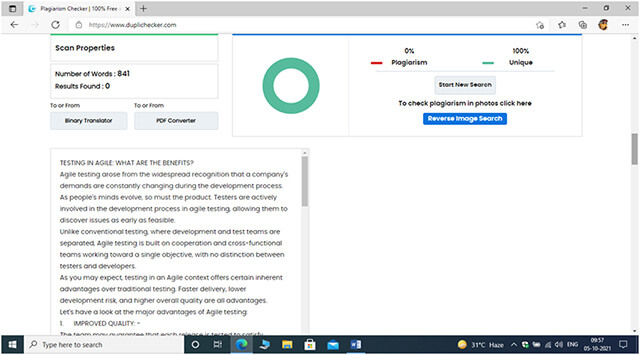
TESTING IN AGILE: WHAT ARE THE BENEFITS?
Agile testing arose from the widespread recognition that a company’s demands are constantly changing during the development process. As people’s minds evolve, so must the product. Testers are actively involved in the development process in agile testing, allowing them to discover issues as early as feasible.
Unlike conventional testing, where development and test teams are separated, Agile testing is built on cooperation and cross-functional teams working toward a single objective, with no distinction between testers and developers.
As you may expect, testing in an Agile context offers certain inherent advantages over traditional testing. Faster delivery, lower development risk, and higher overall quality are all advantages.
Let’s have a look at the major advantages of Agile testing:
1. IMPROVED QUALITY: –
The team may guarantee that each release is tested to satisfy customer expectations by testing the product progressively and leveraging test infrastructures such as CI/CD systems.
Furthermore, Agile testing produces rapid findings in shorter cycles, increasing project quality visibility. When necessary, this enables the development team to take remedial action to improve product quality and performance.
2. INCREASED INTERACTION: –
Teams, people, and interactions are the highlights of agile testing. Any obstacles, preferences for certain tools, and techniques are all discussed in detail among team members.
During their sprints, testers engage with developers, business analysts, the Scrum Master, and the Product Owner. The testing process becomes nimble as a result of these interactions.
3. HIGH-QUALITY PRODUCT: –
Unlike typical testing, which starts at the beginning of the project and ends at the end, testing starts at the beginning of the project. As a result, testers may address any issues that arise over the course of the project. In an agile environment, testers and developers are in constant contact.
Testers and developers are both participating in the process, and their abilities are utilised. There is constant input, and any issues may be readily fixed. Furthermore, testers and developers are in contact with customers, who may provide feedback to aid in the development of a high-quality product.
4. FASTER DELIVERY: –
The product is tested at the conclusion of the development process via waterfall testing. If anything has to be changed, the project will begin over from the beginning and this may cause delivery to be delayed.
There is constant feedback and communication when teams utilise agile in testing. Separate sprints make up the development process, and testers can repair bugs in the middle of a project. As a consequence, a high-quality product is delivered more quickly and on schedule.
5. INCREASED PREDICTABILITY: –
The team estimates testing effort for every functionality they want to offer as part of any new development. This allows the team to make more accurate estimates since they estimate a small portion of development rather than the entire project’s testing work (which almost never reflects the true timeline).
6. CONTINUOUS FEEDBACK BASED ON INCREMENTAL RELEASES: –
Agile iterative and incremental approaches assist shorten the time between defining requirements and delivering a tested, incremental version to the client. This guarantees that the team receives immediate and ongoing feedback on the quality of their individual deliverables, rather than waiting months or even years for the same input as in conventional software development.
7. FEWER CODE CHANGES BETWEEN FIXES: –
Between the moment an issue is discovered and the time a developer begins working on it, the code base might change many times in conventional development. When a developer is attempting to replicate an issue, this might add time to the process.
Because testing and coding activities are conducted near to each other under Agile, this scenario is less important. Developers haven’t had enough time to modify the code, making it more difficult to reproduce.
8. AN EFFICIENT WAY TO HANDLE SOFTWARE BUGS: –
When compared to traditional testing, agile testing gives a better way of dealing with software issues. Bugs are closed faster with Agile testing since they are part of the day-to-day development and testing processes. When testers and developers are in the same physical area, they may provide quick feedback without putting the code at risk.
9. TESTING IS AN INTEGRAL PART OF THE PROCESS AND CAN’T BE IGNORED: –
Testing is done continually throughout the software development life cycle in an Agile setting; it cannot be neglected or decreased significantly. This is crucial in Agile testing, because in traditional projects, the testing period is frequently shortened in order to meet deadlines.
10. COLLECTIVE OWNERSHIP OF TESTING: –
In a conventional test environment, the testing team was solely responsible for testing. Each team member is a potential contributor to the testing effort in Agile testing because the entire team is responsible for the quality.
CONCLUSION:
A good agile testing process requires several key elements. First and foremost, you must recruit testers with critical abilities such as self-organization, communication, and scripting. Then you must determine which agile testing approach is best for your team. To guarantee the successful delivery of a high-quality product, make sure your testers work closely with the developers.



